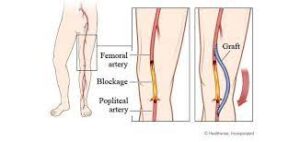
Peripheral vascular bypass refers to the surgical revision of blood flow to restore perfusion distal to an occluded or otherwise disrupted arterial segment. PVB procedures can involve any of the arteries excluding those in the heart or the brain. These open surgical procedures are typically done by vascular surgeons, cardiologists, or interventional radiologists.
Peripheral artery bypass is surgery to reroute the blood supply around a blocked artery in one of your legs. Fatty deposits can build up inside the arteries and block them.
A graft is used to replace or bypass the blocked part of the artery. The graft may be a plastic tube, or it may be a blood vessel (vein) taken from your body (most often the opposite leg) during the same surgery.PVB procedures can be accomplished via anastomosis with any of the main arteries except those located in the head.PVB is applied in the management of certain traumatic arterial injuries, or aneurysms, and most commonly for peripheral arterial disease (PAD). PAD is the result of atherosclerotic plaque causing stenosis of the arteries supplying the lower extremities. Symptoms of PAD range from asymptomatic, to demand ischemia or claudication, to Critical Limb Ischemia (CLI), characterized by severe disability and tissue loss. For these patients, PVB is considered if they have severe disease burden that is not amenable to endovascular therapy, or they have failed therapy previously. Lesions that are not responsive include severe stenosis and hostile vascular anatomy which would make endovascular treatment technically challenging.for more information
